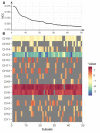Pitch Processing Can Indicate Cognitive Alterations in Chronic Liver Disease: An fNIRS Study
- PMID: 33132872
- PMCID: PMC7578697
- DOI: 10.3389/fnhum.2020.535775
Pitch Processing Can Indicate Cognitive Alterations in Chronic Liver Disease: An fNIRS Study
Abstract
Early detection and evaluation of cognitive alteration in chronic liver disease is important for predicting the subsequent development of hepatic encephalopathy. While visuomotor tasks have been rigorously employed for cognitive evaluation in chronic liver disease, there is a paucity of auditory processing task. Here we focused on auditory perception and examined behavioral and haemodynamic responses to a melodic contour identification task (CIT) to compare cognitive abilities in patients with chronic liver disease (CLD, N = 30) and healthy controls (N = 25). Further, we used support vector machines to examine the optimal combination of channels of functional near-infrared spectroscopy that can classify cognitive alterations in CLD. Behavioral findings showed that CIT performance was significantly worse in the patient group and CIT significantly correlated with neurocognitive evaluation (i.e., number connection test, digit span test). The findings indicated that CIT can measure auditory cognitive capacity and its difference existing between patient group and healthy controls. Additionally, optimal subsets classified the 16-dimensional haemodynamic data with 78.35% classification accuracy, yielding markers of cognitive alterations in the prefrontal regions (CH6, CH7, CH10, CH13, CH14, and CH16). The results confirmed the potential use of behavioral as well as haemodynamic responses to music perception as an alternative or supplementary method for evaluating cognitive alterations in chronic liver disease.
Keywords: chronic liver disease (CLD); cognitive alteration; functional near-infrared spectroscopy (fNIRS); haemodynamic response; melodic contour identification; nonverbal auditory perception/music perception.
Copyright © 2020 Jo, Kim, Jun and Jeong.
Figures







References
-
- Agostini G., Longari M., Pollastri E. (2003). Musical instrument timbres classification with spectral features. Eurasip J. Appl. Signal Proces. 1:943279 10.1155/S1110865703210118 - DOI
-
- Amodio P., Montagnese S., Gatta A., Morgan M. Y. (2004). Characteristics of minimal hepatic encephalopathy. Metab. Brain Dis. 19, 253–267. 10.1023/B:MEBR.0000043975.01841.de - DOI - PubMed
LinkOut - more resources
Full Text Sources

